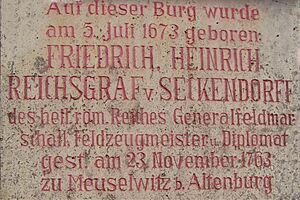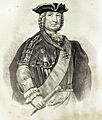Friedrich Heinrich von Seckendorff facts for kids
Friedrich Heinrich von Seckendorff (born July 5, 1673 – died November 23, 1763) was an important German military leader and diplomat. He served the Austrian Empire for many years. Later, he became the commander of the Bavarian army and even fought against Austria. He lived to be 90 years old.
Contents
Early Life and Education
Friedrich Heinrich von Seckendorff was born in Königsberg, a town in Franconia, Germany. He came from a noble family called the Seckendorff family. His father worked for the Saxe-Gotha region. Friedrich Heinrich studied law at several universities, including Jena, Leipzig, and Leyden.
Starting His Military Career
Seckendorff began his military journey in 1693. He joined an army led by William III of England. In 1694, he became a cornet, a low-ranking officer, in a cavalry unit that was paid by Austria.
He later served as an infantry officer for Venice. In 1697, he joined the army of Ansbach. This regiment later became part of the Imperial army in 1698. He fought in the Great Turkish War under the famous commander Prince Eugene of Savoy.
Key Battles and Promotions
In 1699, Seckendorff got married and returned to Ansbach. However, the War of the Spanish Succession soon began. He rejoined the army as a lieutenant-colonel. During this war, he led his dragoons (a type of cavalry) and captured 16 enemy standards at the Battle of Blenheim.
He was promoted to Oberst (a higher rank). Seckendorff also took part in important battles like Ramillies and Oudenaarde. He also helped in the siege of Ryssel.
Feeling that he wasn't being promoted fast enough, Seckendorff joined the service of King Augustus II of Poland. He became a Generalmajor (a general) and led Saxon troops in Flanders. He fought in the siege of Tournai and the battle of Malplaquet.
As a diplomat for Poland, he helped with the negotiations for the 1713 Treaty of Utrecht. In the same year, he helped stop a rebellion in Poland. As a lieutenant general, Seckendorff commanded Saxon troops in the 1715 siege of Stralsund against King Charles XII of Sweden.
Seckendorff returned to the Austrian Imperial service in 1717. He became a Feldmarschallleutnant (a high-ranking general). He led two regiments against the Ottoman Turks at Belgrade under Eugene of Savoy. In 1718, he fought successfully against Spain in Sicily. In 1719, he was given the title of Reichsgraf (Imperial Count). Two years later, he was named Feldzeugmeister (another high military rank).
Diplomatic Missions
In 1726, Seckendorff became the Austrian ambassador to the Prussian court in Berlin. He became good friends with King Frederick William I of Prussia. They had fought together in the War of the Spanish Succession.
Seckendorff also influenced important Prussian officials. He helped Austria by making sure that Crown Prince Frederick (who later became Frederick the Great) married Elizabeth Christina of Brunswick-Bevern. This marriage was better for Austria than a marriage to a British princess.
Thanks to Seckendorff's diplomatic skills, many German states, Denmark, and the Dutch Republic agreed to the Pragmatic Sanction. This was an important rule that allowed a female, Maria Theresa, to inherit the Austrian throne.
Later Military Career
In 1734, Seckendorff returned to the Imperial army. He became the Governor of Mainz. During the War of the Polish Succession, he led 30,000 troops against the French at the Battle of Clausen in 1735.
In 1737, Emperor Charles VI made Seckendorff commander-in-chief in Hungary. He also gave him the rank of Feldmarschall (Field Marshal). He had some early successes in the war against the Ottomans. However, he was eventually forced to retreat. His enemies in Vienna then had him arrested and imprisoned in Graz.
Empress Maria Theresa released Seckendorff from prison in 1740. But he was not paid what he was owed. So, he left all his Austrian jobs. He then accepted a new role from the Bavarian Emperor Charles VII. He became a field marshal in the Bavarian army.
As commander of the Bavarian army, Seckendorff helped free Munich during the War of the Austrian Succession. In 1743 and 1744, he won several battles. He forced the Austrians back into Bohemia. After these victories, he resigned from his position.
After Emperor Charles VII died, Seckendorff helped negotiate peace between Austria and Bavaria. This led to the Treaty of Füssen in 1745. Emperor Francis I confirmed all of Seckendorff's honors. Seckendorff then retired to his estate at Meuselwitz in Thuringia.
In 1757, his wife passed away. This greatly affected his health. During the Seven Years' War in 1758, Prussian soldiers captured Seckendorff from his home. He was held in Magdeburg for about six months. He was then exchanged for another captured general. Seckendorff returned to Meuselwitz and died there in 1763.
Images for kids
See also
 In Spanish: Friedrich Heinrich von Seckendorff para niños
In Spanish: Friedrich Heinrich von Seckendorff para niños





